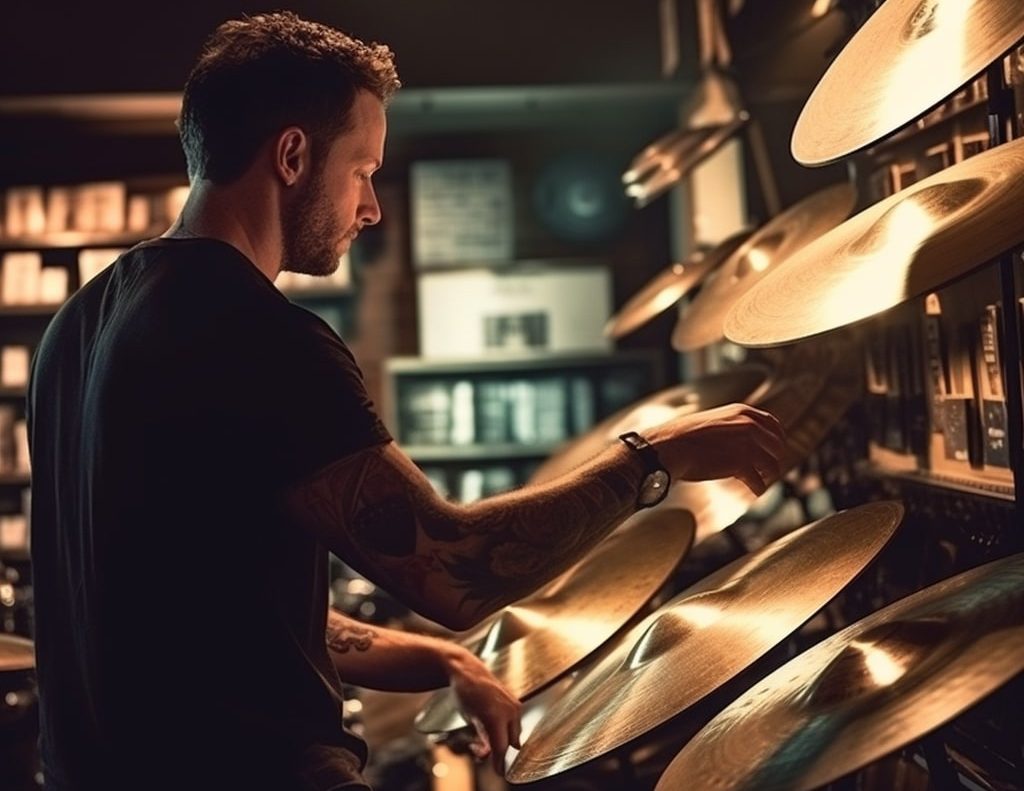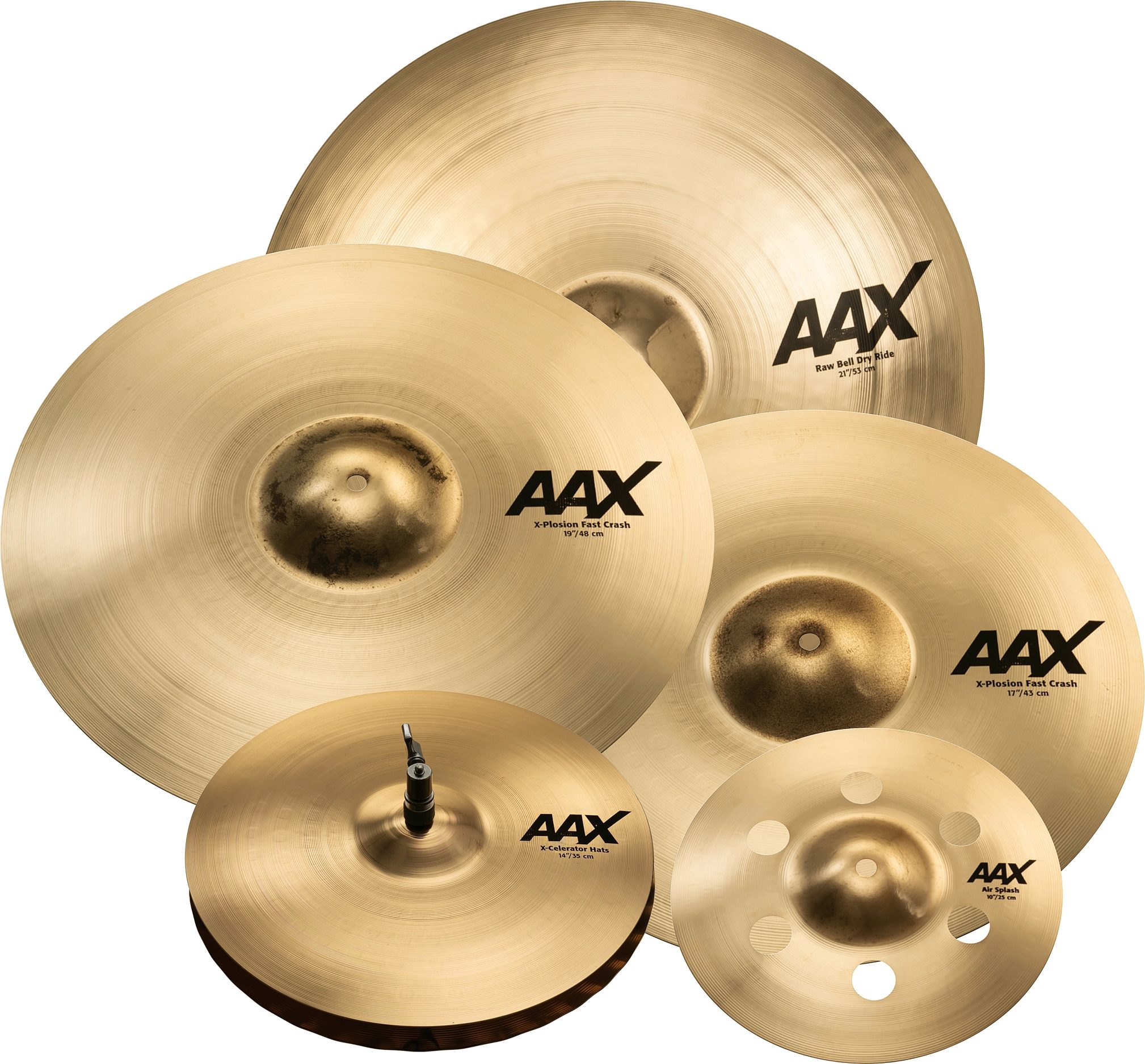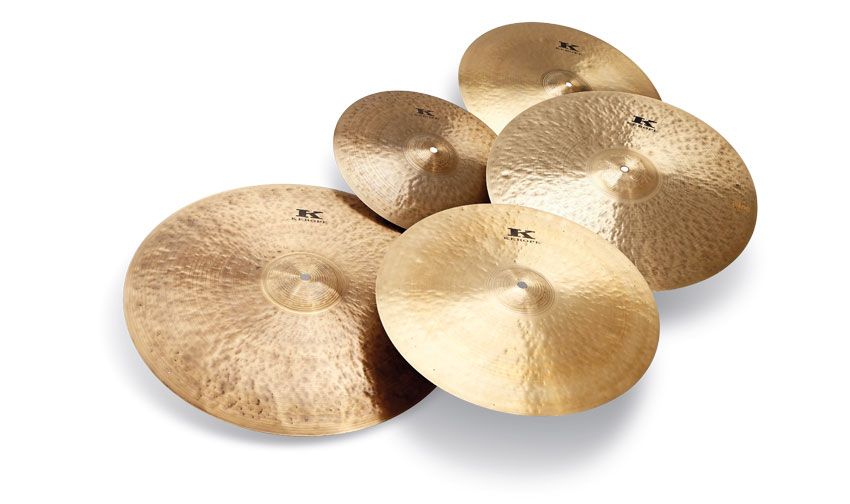To choose the right cymbals, you need to know a couple of crucial things that can affect your playing.
One of them is the diameter of the cymbal, its thickness, and the material the cymbals are made of.
Now we will review 7 best cymbals for rock, jazz, versatility, beginners etc.
Let’s dive in.
Understanding Cymbals: A Basic Guide
Before I move on to the review part, let’s check this basic guide for choosing the best cymbals according to your needs.
Check this section, especially if you are a rookie or need a better understanding of how cymbals work.
What are cymbals?
Cymbals are a popular type of percussion instrument. They are thin, typically spherical plates of various metals that are often used in pairs.
Cymbals are usually crafted of round, flat, or concave metal plates.
You will need a pair of drumsticks to strike it with to play it and create sounds. Such an instrument contributes significantly to the overall sound of a drum set.
How do cymbals contribute to the drum set’s sound?
They produce very diverse sound effects for the drumset. They produce the sound when being struck and cannot be tuned like drums. But they can also produce sound when striking one cymbal against the other.
This causes the rim to vibrate the most while the center stays static. These vibrations make sounds. Thus, the rims of the plates are also struck against each other while being held by the straps in the middle.

Different Types of Cymbals
Now that we understand better what cymbals are and how they work let’s explain what are the different types of cymbals out there.
A crash cymbal is a type of cymbal that creates a sharp and loud sound and is mainly used for accents. It can be played on a stand with a drumstick or by hand in pairs.
It is recommended that a drum set should have one or two crash cymbals. This way, you will have better transitions between sections when playing, but also during your solos or at the end of the song.
The ride cymbal job is to “maintain a steady pattern.”
Compared to crash cymbals, ride cymbals are thicker and have a wider diameter. Ride cymbals are often used since they help keep the beat, while crash cymbals are used infrequently to provide accents.
Hi-hat cymbals are two cymbals mounted on a stand with a pedal. It is used for all styles of music, from rock to jazz and pop. The hi-hat produces a short, sharp, muted percussive sound known as a “chick”. You will receive this sound when struck closed or played with a pedal.
You can adjust the space between the cymbals. This will affect the sound of an open hi-hat from a shimmering, sustained tone to something akin to ride cymbals. One of the best hi hat cymbals is Zildjian A New Beat 14”.

Top Brands for Cymbals
Okay, now we understand what each cymbal represents and what’s its purpose. The next step is to get to know some of the best cymbal manufacturers that you can find.
Here are the best cymbal brands that have a wide offer from those rookie drummers to professionals. Let’s check them.
Zildjian
Zildjian is the most popular cymbal brand. But also manufactures the best drum cymbals ever. Founded in 1623. in Constantinople, today’s Istanbul. Zildjian is one of the oldest cymbal manufacturing companies.
Interesting fact terms like ride and crash originated at Zildjian Company. They manufacture around 600 distinct varieties of cymbals ranging in size from 6″ to 24″ and have over 250 thousand cymbals in their vault.
Sabian
Sabian is a Canadian company popular for manufacturing cymbals and Zildjian’s biggest competitor.
But, believe it or not, Robert Zildjian founded the company due to a fight with his brother. Yup, you heard that right. Robert was a brother of Avedis Zildjian, who founded the Zildjian Company.
Sabian is now one of the big four manufacturers of cymbals. Alongside Zildjian and Sabian, there are also Meinl and Paiste. This company offers cymbals to all levels of drummer, from beginners to professional ones, as well as all styles of music.
The Artisan, HH and HHX series are Sabian’s highest-quality cymbals. If you’re concerned about the sound, the AA cymbals provide that brighter, while the HH that a darker tone.
Meinl
Another amazing cymbal manufacturer is Meinl. The company was founded in 1951. by Roland Meinl. Meinl is also well-known for being the first cymbal maker to provide pre-packaged cymbal packs back in 1974.
They are a corporation that is highly focused on both quality and innovation. The greatest thing about their cymbals is that they use six different alloys to create cymbals, which is more than any other cymbal maker company.
For years, the company was focused on creating low-budget cymbals.
However, they eventually started manufacturing pro cymbals, which led to their first pro series, the “King-Beat Series.” Meinl’s most popular and professional line of cymbals is the Byzance, which is constructed of B20 alloy.
Paiste
The last one of the big four is Paiste. Toomas Paiste, an Estonian musician, founded the company back in 1906 in Saint Petersburg. They are not as well-known as Zildjian, but they are nonetheless regarded as one of the top cymbal companies.
They craft high-end cymbals with great innovations in mind. Paiste invented the Flat Ride, a popular ride cymbal without a bell. This was Paiste’s main’ breakthrough.
They also pioneered using B8 bronze as a cymbal alloy and were the only major firm to do so for high-end models for many years.
Istanbul Agop
Even though Istanbul’s company is not a part of the big four, it still crafts amazing cymbals. Istanbul Agop is one of two enterprises that started operating independently following the separation of the Istanbul Cymbals Company.
Though the Istanbul Agop company began by producing exclusively jazz cymbals, it has now grown, and they craft cymbals for all sorts of music styles. They now sell hand-hammered, traditional, and contemporary cymbals as well.
Factors to Consider When Buying Cymbals
Material: What are cymbals made of, and how does it affect the sound?
All cymbals are made from copper alloy, and there are four different types, including:
- Bell bronze;
- Malleable bronze;
- Brass;
- Nickel silver.
Bell bronze is the most popular type of all cymbal alloy. It is made with copper alloy with tin. The copper provides cymbals with a bright, crisp tone that cuts through a musical performance.
The alloy used to make a cymbal significantly impacts its sound. Most professional models are built of an 80% bronze alloy with 20% tin. This alloy is known as B20, and nearly all manufacturers use it.
A B20 bronze cymbal has the widest frequency range of any cymbal. You can use it in various ways to sound darker or brighter, depending on the intended effect. B20 cymbals produce a wide range of frequencies, making your drumming more versatile.
On the other hand, there are Malleable bronze cymbals that contain 8% of tin in the copper alloy. Thus, it is also known as B8 alloy. They are a great option for those who would like the quality of bronze but are short on the budget.
As commercial sheet metal, it is available in a number of grades and thicknesses. B8 cymbals offer a very bright and concentrated sound. Suppliers frequently cast them before bringing them to cymbal manufacturers, making them less expensive.
Brass cymbals are also good but are limited in sound as well as durability. Brass cymbals include 38% zinc in copper and are the most basic cymbals. These are also great cymbals for beginners on a budget.
Compared to all bronze alloys, brass cymbals sound significantly muted. Because of the stiffness of brass, these cymbals have a harsh sound and are prone to fractures around the bell hole and border. Thus, they usually don’t last long.
Nickel silver cymbals consist of a copper-based alloy containing 12% nickel. They are often fairly thin with a powerful tone that lacks the shimmer and sensitivity of tin bronze cymbals.
This alloy is used in some beginner’s cymbals as well as a small number of specialty high-quality cymbals. Especially high-quality bongs with modern and exotic sounds are known to be made with nickel silver.
Size: How does the size of a cymbal affect its sound?
There are usually three main types of cymbal sizes:
- 14”
- 16”
- 18”
The size of the cymbal affects the cymbal sound. Thus, the smaller the cymbals, the higher the pitch. The larger the cymbal, the lower the pitch. Larger cymbals have more overtones and lower pitch, whereas smaller cymbals have a quicker decay and higher pitch.
So in accordance with your style, choose the size of your cymbals. Here’s a little help. If you are a rookie, start with 16” cymbals. This is a general rule because you can easily maneuver and strike the cymbal without being too big or small.
Thickness: What role does thickness play in a cymbal’s sound?
The same rules apply to the cymbal thickness. The thicker the cymbal, the higher the pitch. The thinner the cymbal, the lower the pitch.
If you frequently perform rock music, a thicker cymbal can endure the thunderous crashes better than a thinner cymbal. Thick cymbals have quicker vibrations and a higher tone in general.
Thinner cymbals generate slower vibrations, resulting in a quieter tone. Many people choose thin cymbals because they sound great and are quiet. But, the issue with thin cymbals is that they must be smashed hard in order to be heard on stage, which increases the risk of cymbal cracking.
A cymbal’s output level is affected by its weight and thickness, as low-frequency sound waves take more energy to transmit than high-frequency sound waves.
Budget: How much should you expect to spend on quality cymbals?
Cymbal quality can vary. Thus, the budget varies as well. Here is some general rule of how much cymbals can cost you.
- Entry-level, beginner cymbal set: from $100 to $400
- Mid-level, intermediate cymbal set: from $400 to $700
- Pro-level, professional cymbal sets: from $700 to $2000
You should bare in mind that a cymbal set can cost you more than the drum set itself. Especially when buying high-quality cymbals. If you are a bit on a budget and still want a quality set, consider buying used cymbals in good condition.
Best Cymbals

Sabian HHX Evolution
- Bright, glassy tone, low pitch
- Made of B20 Bronze
- Highly responsive
9.9

Sabian AAX
- Modern bright sound
- Made of B20 Bronze
- Cut through the music
9.3

Meinl Byzance Brilliant
- Bright, rich, and warm sound
- Made of B20 Bronze
- Hand hammered
9.5

Paiste Rude
- Powerful, and metallic tones
- Made of 2002 Bronze
- Traditionally handcrafted
9.1

Zildjian Kerope
- Dark, complex, and warm sound
- Made of Zildjian's secret alloy
- Handcrafted using traditional techniques
9.9

Paiste PST 7
- Bright, clear sound
- Made of 2002 Bronze
- Wide tonal range and medium sustain
8.5

Paiste Giant Beat
- Wide, dynamic range and responsive feel
- Made of 2002 Bronze
- Handcrafted
9.5
If none of these series doesn’t suit you, fill out my “Cymbal Finder” below and I will handpick some cymbals for you.

Fill out the form, and I will hand-pick the best cymbals for you and drop you an email.
Cymbal Care and Maintenance
How to clean and maintain cymbals to extend their life?
Cymbal cleaners from well-known firms like as Paise, Zildjian, and others are the best way to clean cymbals. It will remove oxidation and renew the tone of the cymbals. To learn exactly how to clean your cymbals, check this blog for detailed steps.
But here are also a few tips to go. You can try and clean cymbals in a more old-fashion way. This means using home remedies. Get some lemon and squeeze juice around the cymbal, then pour some vinegar on top. Start rubbing slowly with a dry cloth but avoid the logo.
Vinegar is pretty strong, so using too much of it can remove the logos. After a few hours, wipe it clean with a moist towel, and you’re done. But bare in mind that cleaning cymbals using household things is possible but less effective.
What are some common mistakes to avoid when caring for cymbals?
There are a couple of things that beginners are usually prone to do when caring for their cymbals. Here is what you should pay attention to.
Incorrect handling. Do not touch cymbals with dirty hands and try to avoid touching the cymbal surfaces as much as you can. To avoid fingerprints when transporting cymbals, put two hands on the perimeter of the cymbal. Oils and sweat from your hands can tarnish the metal over time. Also, spills and dirt should be cleaned immediately with warm water and soap.
Overcleaning. As important as it is to keep them clean, cymbals don’t need to be spotless. Cleaning them too often can cause more harm than good. The abrasives in the cymbal cleaning polishing compound can wear your cymbal down to the lathing, resulting in a change in tone. Clean them only after the performance or long practice session, which should be enough.
Inappropriate storage. Don’t stack cymbals directly on top of each other. Use a cymbal bag if you have one. This is the best way to protect them both when stored at home or when traveling. If you don’t have the bag, use soft cloth separators. Then, put them in a dry and safe place away from humidity. This is because moisture and metal do not get along and can cause corrosion and rust.
Inappropriate playing technique. When playing the cymbal, keep the drumstick slack and relaxed in your hands to let the cymbal generate its sound and to extend its longevity. Keep the drumstick loose. This will relieve the contact with the cymbal, allowing the cymbal’s sustain to linger longer. When crashing, make sure the cymbal is at the proper angle, with a small tilt towards you as you play.
Ignoring signs of damage. Look for any signs of damage, like cracks or keyholing. Address these issues right away to prevent further damage.

Frequently Asked Questions
What are the best cymbals for beginners?
All of the big four cymbal companies have great offers for beginners. Here are some of the best cymbal packs for each one of them.
Paiste
- Paiste PST 7
- Paiste PST X
Sabian
- Sabian B8X
- Sabian SBR
Zildjian
- Zildjian S series
- Zildjian I Series
Meinl
- Meinl Cymbals HCS
- Meinl Classics Custom Dark
How often should I replace my cymbals?
It depends on the quality of your cymbals, playing styles, and maintenance. Most drummers with good playing styles and who maintain their cymbals properly can use them for up to 20 to 30 years if not more.
If quality cymbals break after a short period of time, you should replace them. But this is probably not because of the quality of your cymbals but your playing style. Thus, consider acquiring appropriate cymbals for your genre.
Can cymbals crack, and what can I do if it happens?
Yes, cymbals can crack. This usually happens when there is too much stress put on them.
As you may be aware, a cracked cymbal has two issues: the sound will undoubtedly change, and the sharp point of the break will concentrate the tension in that particular area of the metal.
Repairing broken cymbals involves addressing these two issues; in each case, the crack point must be blunted. Overall, it is critical to smooth off the edges to minimize any damage from growing into new fractures.
Conclusion
Getting into the world of drumming means learning a lot of new things. One of them is understanding cymbals. There are four main types of cymbals: ride, crash, hi-hat, and specialty. Each one of them has its purpose and distinct sound.
Once you know them, ensure that you understand how the material, size, and thickness influence the sound of your cymbals.
When it comes to choosing the best ones, my recommendation is to choose from the big four, Zildjian, Meinl, Paiste, and Sabian.
Whether you are a rookie player or a professional drummer, these four manufacturers can’t do anything wrong. You will find your perfect cymbal pack within these companies.
My name is Denis. I am a drummer, percussionist, music enthusiast, and blogger. Drums have been my passion for 15 years now. My idea is to write about the things I like and I am interested in. I want to share my drum passion with fellow musicians who walk, talk, and breathe drums.







[…] For additional information check out http://drumthat.com/best-cymbals-complete-guide/ […]
[…] Masters are some of the best cymbals Paiste has to offer since […]